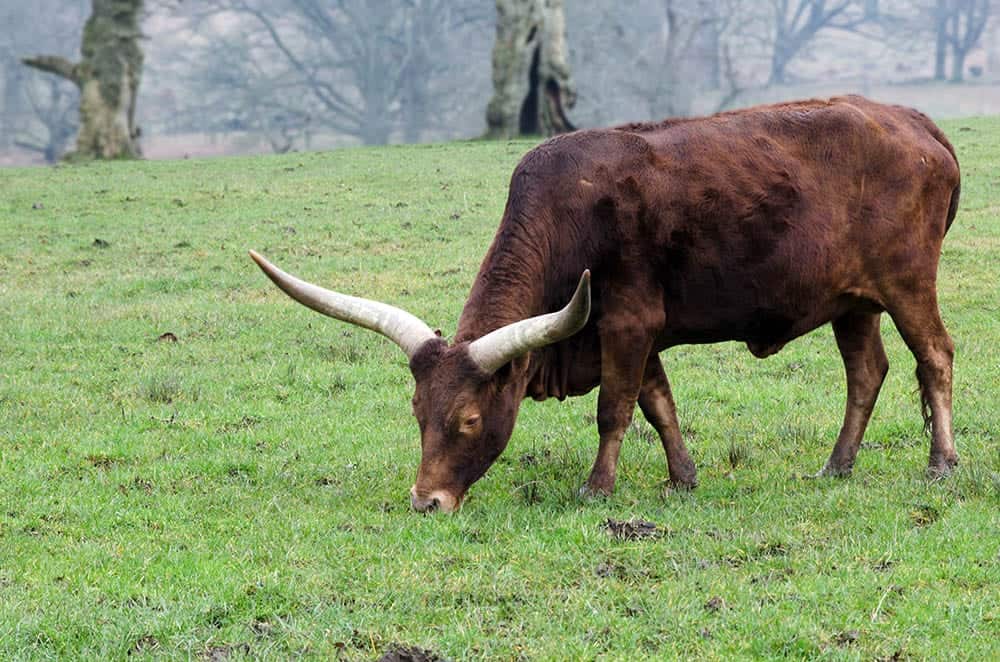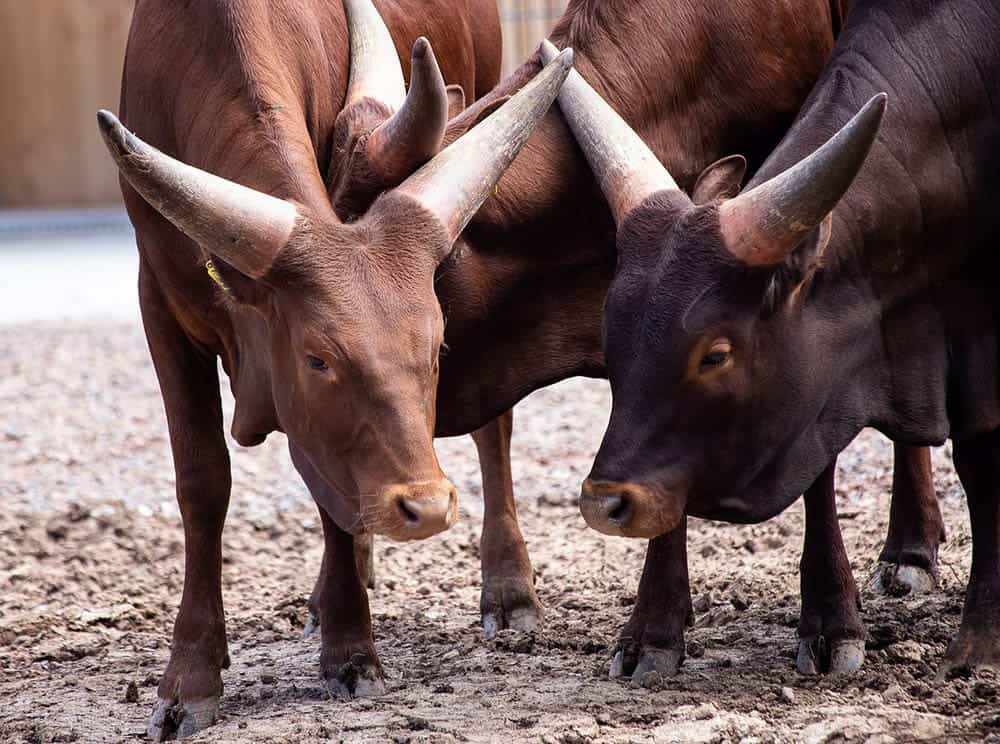The Watusi cattle breed is a truly striking breed in the cattle kingdom. Known for their exceptionally large horns, these animals come from an amazingly long and old line of cattle. They are incredibly gentle creatures with a sweet nature, making them wonderful to have in petting zoos or for use in cattle shows.
Though they are used for milk, meat, and show, this breed is still a bit of a novelty, so there aren’t many in the United States. They don’t produce much milk themselves but can improve other breeds’ via crossbreeding. And while the breed’s meat is supposed to have many fabulous qualities, few people sell it. Thus, while used by farmers, they are more often used for show.

We’ve gathered the information you need on this breed, plus pictures, so you can learn everything you need to know about the Watusi.
| Breed Name: | Watusi |
| Place of Origin: | East Africa |
| Uses: | Multipurpose |
| Bull (Male) Size: | 1,000 to 1,600 lbs |
| Cow (Female) Size: | 900 to 1,200 lbs |
| Color: | Dun, black, dark-red, spotted |
| Lifespan: | 20-26 years |
| Climate Tolerance: | Most climates, including extreme |
| Care Level: | Novice to intermediate |
| Production: | Milk, meat, show |
Watusi Cattle Breed Origins
The Watusi come from an ancient breed of cattle originating in East Africa over 2,000 years ago. Thought to have descended from Hamitic Longhorn and Zebu cattle, the Watusi is a breed that has been valued for much time in African culture both as a symbol of status and as a ceremonial animal.
But, it was only sometime in the early 1900s that this breed left East Africa when they were sent to the U.S. and Europe, mainly to be exhibited in zoos. Around the 1920s-1930s, cattle breeders in the U.S. started bringing them in to be used on farms.

Watusi Cattle Breed Characteristics
The Watusi are herbivores who enjoy a diet of leaves, grass, and hay. Thanks to their digestive systems, they are able to live on less food and water if needed; this is what has helped them survive for so long. That doesn’t mean they should be fed less, just that if times are lean, they’ll manage.
Because this breed is a medium-sized one, newborn calves tend to be on the smaller side (only 30-50 pounds). Breeders find this useful as it means the bulls can breed to first-calf-heifers of other breeds.
Due to their history in East Africa, the Watusi can tolerate extreme temperatures and weather well, making them a good breed for nearly any climate. Their horns play a part in this as they act as a cooling system for the body. Those horns can also be used as dangerous weapons if the cattle are attacked.
The milk of the Watusi only contains around 10 percent fat, which is why they are sometimes used by dairy farmers to crossbreed with the farmer’s current herd. Doing this boosts the butter-fat levels in milk, making it even tastier.
You’ll find that these cows have a very docile and gentle temperament (although you should watch out for those horns if a bull is feeling aggressive!). This breed is a fairly easy one to keep.
Uses
Watusi cattle are used for a variety of purposes, including for milk, meat, and show, though their main uses are for milk and show. They don’t produce much milk themselves, but because their milk only contains the aforementioned 10 percent of fat, they are used in crossbreeding to boost the levels of butterfat in the milk of other cattle.
As far as meat goes, they are used for this purpose less often than other breeds. Their meat has a lot to offer, though, as it is leaner and contains less cholesterol than other kinds of beef.
This breed is still a bit of a novelty breed, so they tend to be used more for show, either in cattle shows or even petting zoos.

Appearance & Varieties
The Watusi cattle breed is a medium-sized one with sweeping horns that have a large base. These horns have been known to reach lengths of nearly 8 feet from tip to tip. In fact, this breed has the longest horns of any cattle breed! Their horns act as a cooling system for the cattle—blood that gets circulated in the horns cools, then goes back to the body, which lets excess heat disperse—which helps them to survive in scorching climates.
This breed has a topline that is straight, a rump that slopes and some cattle may have a neck hump. They may be spotted or solid in colors, including dark-red, black, and dun (with dark red being the primary color of this breed). The spotted cattle may have unusual patterns at times, including a pattern where color runs on the top of the body while the bottom is white. You might even find some cattle that are speckled.
Population/Distribution/Habitat
According to the Livestock Conservancy, only about 1500 Watusi cattle can be found outside of Africa, with the majority (80%) being located in the United States. The population is much more abundant in their home habitat, although there have been declines due to war and economic upheaval. The approximate population in Uganda is said to be 2.9 million.

Are The Watusi Cattle Breed Good for Small-Scale Farming?
Though the Watusi cattle breed can survive on less food and water than normal cattle breeds, making them more sustainable, the fact that they don’t produce much milk or meat makes them less suitable for small-scale farming. This breed may up the butterfat levels in milk and produce leaner meat with less cholesterol, but overall, they are used more for show than anything. Small-scale farms may find that the output of the breed doesn’t make the needed upkeep worth it.

Conclusion
The Watusi cattle breed is a genuinely stunning breed of cattle with their large horns and ancient bloodlines. However, they are more suitable for those looking to crossbreed first calf heifers or improve the amount of butterfat in their milk rather than those who are looking to produce milk and meat for themselves and distribution. This breed will be especially good for those who attend cattle shows or those who have places to put them on show, such as petting zoos, due to their gentle temperaments.
- Next on your reading list: How Many Cows Are in Wisconsin?
Featured Image Credit: Paula Cobleigh, Shutterstock
